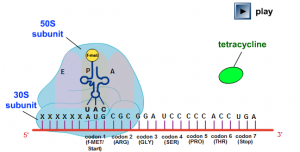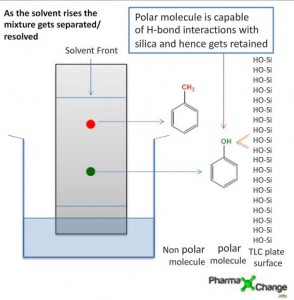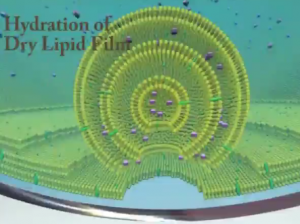Vancomycin is an antibiotic drug which is structurally classified as a glycopeptide. It mainly acts by prevention of cell-wall biosynthesis of bacteria. It is specially effective against gram-positive bacteria and has been known to be effective against resistant strains of MRSA. Vancomycin is known as the drug of last resort as it generally used when all other treatments have failed. However, bacteria have started developing resistance to vancomycin as well- leading to use of other antibiotics.
There are two animations which describe the mechanism of action of vancomycins. The first one is the older animation while the second one is the newer animation.
1] Older animation

2] Newer animation
[swfobject]1194[/swfobject]
Mechanism of Action
Vancomycin acts by inhibiting cell wall synthesis of bacteria. Peptidoglycan layer of the cell wall is rigid due to its highly cross-linked structure. During the synthesis of the peptidoglycan layer of bacteria, new building blocks of peptidoglycan get inserted (i.e. monomers of N-acetylmuramic acid and N-acetylglucosamine) into the membrane. Reformation of the peptide cross links occurs by the enzyme transpeptidase. Vancomycin binds to the building blocks (i.e. NAG and NAM) of the peptidoglycan and prevents the transpeptidase from acting on these new formed blocks and thus prevents cross-linking of the peptidoglycan layer. By doing so, vancomycin makes the peptidoglycan layer less rigid and more permeable. This causes cellular contents of the bacteria to leak out and eventually death of the bacteria. Mutations in the transpeptidase enzyme can lead to increased resistance to vancomycin.
The above animations has been supplied by Dr. Gary E. Kaiser from the Community College of Baltimore County– and it illustrates the mechanism of action of vancomycin by inactivation of the peptidoglycan layer biosynthesis. The transcript from his website states:
“During normal bacterial growth, bacterial enzymes called autolysins put breaks in the peptidoglycan in order to allow for insertion of peptidoglycan building blocks (monomers of NAG-NAM-peptide). These monomers are then attached to the growing end of the bacterial cell wall with transglycosidase enzymes. Finally, transpeptidase enzymes join the peptide of one monomer with that of another in order to provide strength to the cell wall. Penicillins and cephalosporins bind to the transpeptidase enzyme and block the formation of the peptide cross-links. This results in a weak cell wall and osmotic lysis of the bacterium.”
References
- Walter P. Hammes1 and Francis C. Neuhaus. On the Mechanism of Action of Vancomycin: Inhibition of Peptidoglycan Synthesis in Gaffkya homari. Antimicrob Agents Chemother. 1974 December; 6(6): 722–728
- Glycopeptide antibiotics By Ramakrishnan Nagarajan



